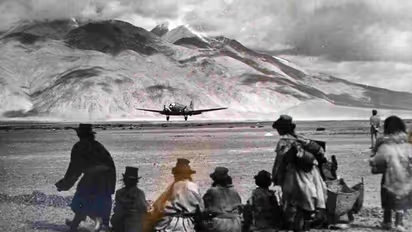From the IAF vault: The engineer from Ladakh who made an airstrip in 26 days

Synopsis
Sonam Norbu, the first engineer from Ladakh, and his team constructed a 2300 yard-long makeshift airstrip at Leh with a budget of Rs 13,000. He still saved Rs 2,109 which he returned to the treasury.
This is the story of Leh airfield and Sonam Norbu, the first engineer from Ladakh who built it in 1948. This runway became India's lifeline during the India-China faceoff on 2020 in Ladakh's Galwan Valley.
Also Read: From the IAF vault: The story of the daring 12 Squadron
By December 1947, Pakistan-aided tribals had advanced up the Shyok and Indus Valleys, the objective being Leh and ultimately the entire Ladakh. Leh, at that time, was garrisoned by a platoon of 33 men of the State Forces.
With no other means available to reinforce the garrison, a company of 2 Dogra set out from Srinagar on February 16, 1948, across the Zojila on foot, crossing it in winters perhaps for the first time. They were accompanied by Sonam Norbu, the first engineer from Ladakh.
He carried Rs 13,000 for constructing an airstrip at Leh. The party reached Leh on March 8, 1948. Construction of the airstrip between the Indus river bed and the town commenced on March 12, 1948, and a 2300-yard-long makeshift airstrip was ready by April 6, 1948.
Norbu had spent Rs 10,891 and deposited the balance amount of Rs 2109 in the treasury. On April 6, 1948, he sent a wireless message requesting dispatch of aircraft and reinforcements.
History was made when Air Commodore Mehar Singh landed the piston-engined Dakota at the 11,000 feet Leh airfield and helped save Ladakh. Norbu later joined the J&K Public Works Department and, as Chief Engineer with the Border Roads Organisation, was instrumental in building the Srinagar-Leh road.
Also Watch: Defence Diaries: The Most Telling Story Of Dakota DC3 'Parashurama'
Also Read: Remembering the Special Forces officer who led from the front
Also Read: The World War II soldier who won an Ashok Chakra
Also Read: Independence Day: The story of the Indian National Flag
Stay updated with the Breaking News Today and Latest News from across India and around the world. Get real-time updates, in-depth analysis, and comprehensive coverage of India News, World News, Indian Defence News, Kerala News, and Karnataka News. From politics to current affairs, follow every major story as it unfolds. Download the Asianet News Official App to stay informed anytime, anywhere.